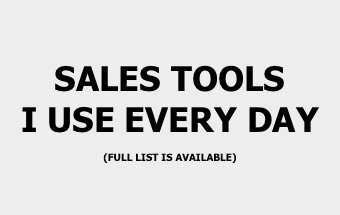I know you can already handle common sales objections. I could too, until I learned a better way to do it. Now it feels more comfortable and natural, like I’m their best friend.
Sure, it’d be great if everyone just said, “yes, I’ll buy your product.” Unfortunately, it rarely works that way.
Instead, your prospects respond with the common sales objections. It’s then your responsibility to handle those objections before you can make the sale.
This is the formula I use. I bet it will work for you too.
What are Common Sales Objections?
Quickly before I describe the Best Friend Formula, I feel it’s necessary to understand what sales objections really mean.
Objections are good. Every time you get an objection, it means the prospect hasn’t hung up on you or walked out of the room yet. So that’s a good thing.
But what sales objections really mean is “I don’t have enough information.” That’s the best way to look at it. Your prospects don’t have enough information to make an informed decision. Your job is to get them that information.
Here are some common sales objections:
- I don’t have time right now.
- I don’t have budget.
- I don’t make decisions.
Let’s go through how you can feel more comfortable and natural when you handle them.
How to Use the Best Friend Formula
I can not take credit for this formula. A very successful sales colleague of mine shared it with me. And since it’s worked so well for me personally, I thought I’d share it with you too.
There are three parts to the Best Friend Formula: Relate, Bridge the Gap, and Ask Again.
I’ll go through each step and then give you a full example of how I used it recently. I tried to write the examples from each step to work in sequence. Theoretically, you can use the first bullet from each step in sequence, the second bullet from each step etc.
Confused? I didn’t think so. Let’s do this.
Step #1: Relate
Prospects want to believe you understand them and have their best interests in mind. So, first relate to their objection. You want to start with where they are (relate to the pain, problem, objection), before you move forward in the process. Here are a few ways to initially respond to a sales objection:
- That makes absolute sense…
- That’s not a problem…
- I’m glad you mentioned that…
Say these words sincerely. Otherwise, you may come off condescending (and nobody likes that). You can expand on these short excerpts further by reiterating their objection afterwards. Example: “That makes absolute sense. I imagine you’re extremely busy.”
Step #2: Bridge the Gap
Now that you’re on their side of the table, you want to bring them back to your side (bridge the gap). You want to validate the prospect’s objection then provide new information that makes it possible for them to take the next logical step. Like this:
- Since you don’t have time right now, I want to let you get back to work.
- Companies like X didn’t have budget either, and that’s what we had in mind when we designed this product.
- I certainly want to make best use of your time. I bet your boss trusts your judgement and you have some influence.
Yes, I know these are overly simplistic examples. But keep reading step #3 where I tie it all together (like a best friend).
Step #3: Ask Again
This is the most important step. How well you execute on the first two steps will determine the quality of your conversion here. Regardless of the first two steps, if you want to WIN, you must ask again. And again. And again.
- Let’s schedule a time to speak next week. What day is most convenient for you?
- Once you see our demo, I can walk you through the pricing in more detail and you’ll see it’s very much within reach. How’s your calendar look toward the end of next week?
- I’d still love to learn more about your process and share some ideas with you. That way next time this does come up internally, you can be most up to speed on what’s possible. I’m pretty open next Wednesday or Thursday afternoon?
Some studies suggest to “ask” at least 3 times before you accept a No. I say go for at least 2, but use your judgement.
Ok. Finally, here’s a recent example where I successfully used the formula end-to-end.
This is How I Used the Formula Recently
I cold called into an account in the mid-west. After the icebreaker, a few questions, and a quick pitch, I asked for the meeting. This is what happened:
Me: Can we find a 30 minute window next week to talk more?
Prospect: Just send me an email. I’ll take a look at my calendar to see if it’s possible (classic sales objection/blow off).
Me: Yeah, that’s not a problem (from step #1 above, nice). What’s the best email to send that to?
Prospect: [email protected]
Me: Great, I’ll send you an email and include some possible times. Just so I propose some reasonable times, is there a day that works better for you?
Prospect: Tuesdays or Wednesdays.
Me: Typically, mornings or afternoons?
Prospect: Afternoon Tuesday.
Me: Great, 3pm Tuesday works for me. I’ll send you a calendar invite as a placeholder.
Whammy. Do you see what happened there?
The prospect’s classic sales objection was subtly transformed into a booked meeting. That’s so nice when you do it right.
Conclusion
Sales is about helping others achieve their goals. You do that by solving a problem. Since most people are inherently resistant to change (including myself), you have to reassure your prospects that you’re looking out for them. Use these examples to kick-start your own sales strategy.
Just remember to relate, bridge the gap and then ask again. I use this formula every day. In fact, I try to become best friends with all my prospects, but sadly, not all of them want to be my friend 
Will you be my friend and share this article with other entrepreneurs and sales professionals?





15 Comments Handle Common Sales Objections Like You Are Their Best Friend